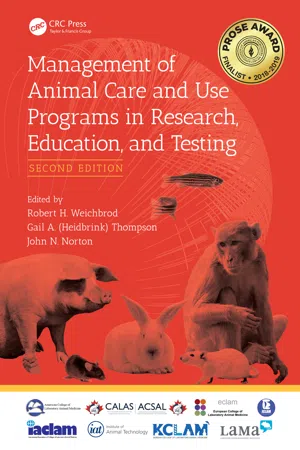
Management of Animal Care and Use Programs in Research, Education, and Testing
- 872 pages
- English
- ePUB (mobile friendly)
- Available on iOS & Android
Management of Animal Care and Use Programs in Research, Education, and Testing
About this book
AAP Prose Award Finalist 2018/19
Management of Animal Care and Use Programs in Research, Education, and Testing, Second Edition is the extensively expanded revision of the popular Management of Laboratory Animal Care and Use Programs book published earlier this century. Following in the footsteps of the first edition, this revision serves as a first line management resource, providing for strong advocacy for advancing quality animal welfare and science worldwide, and continues as a valuable seminal reference for those engaged in all types of programs involving animal care and use.
The new edition has more than doubled the number of chapters in the original volume to present a more comprehensive overview of the current breadth and depth of the field with applicability to an international audience. Readers are provided with the latest information and resource and reference material from authors who are noted experts in their field. The book:
- Emphasizes the importance of developing a collaborative culture of care within an animal care and use program and provides information about how behavioral management through animal training can play an integral role in a veterinary health program
- Provides a new section on Environment and Housing, containing chapters that focus on management considerations of housing and enrichment delineated by species
- Expands coverage of regulatory oversight and compliance, assessment, and assurance issues and processes, including a greater discussion of globalization and harmonizing cultural and regulatory issues
- Includes more in-depth treatment throughout the book of critical topics in program management, physical plant, animal health, and husbandry.
Biomedical research using animals requires administrators and managers who are knowledgeable and highly skilled. They must adapt to the complexity of rapidly-changing technologies, balance research goals with a thorough understanding of regulatory requirements and guidelines, and know how to work with a multi-generational, multi-cultural workforce. This book is the ideal resource for these professionals. It also serves as an indispensable resource text for certification exams and credentialing boards for a multitude of professional societies
Co-publishers on the second edition are: ACLAM (American College of Laboratory Animal Medicine); ECLAM (European College of Laboratory Animal Medicine); IACLAM (International Colleges of Laboratory Animal Medicine); JCLAM (Japanese College of Laboratory Animal Medicine); KCLAM (Korean College of Laboratory Animal Medicine); CALAS (Canadian Association of Laboratory Animal Medicine); LAMA (Laboratory Animal Management Association); and IAT (Institute of Animal Technology).
Frequently asked questions
- Essential is ideal for learners and professionals who enjoy exploring a wide range of subjects. Access the Essential Library with 800,000+ trusted titles and best-sellers across business, personal growth, and the humanities. Includes unlimited reading time and Standard Read Aloud voice.
- Complete: Perfect for advanced learners and researchers needing full, unrestricted access. Unlock 1.4M+ books across hundreds of subjects, including academic and specialized titles. The Complete Plan also includes advanced features like Premium Read Aloud and Research Assistant.
Please note we cannot support devices running on iOS 13 and Android 7 or earlier. Learn more about using the app.
Information
IVProgram Management and Stewardship of Resources
11Human Care
Introduction
What Is a Manager?
Management Activities
Training for Managers
Table of contents
- Cover
- Half Title Page
- Title Page
- Copyright Page
- Table of Contents
- Foreword
- Preface to the Second Edition
- Editors
- Contributors
- Reviewers
- Section I Introduction/Historical Overview
- Section II Developing a Collaborative Culture of Caring
- Section III Compliance, Assessment, and Assurance
- Section IV Program Management and Stewardship of Resources
- Section V Physical Plant
- Section VI Environment and Housing
- Section VII Husbandry
- Section VIII Animal Health and Care
- Section IX Conclusion
- Index